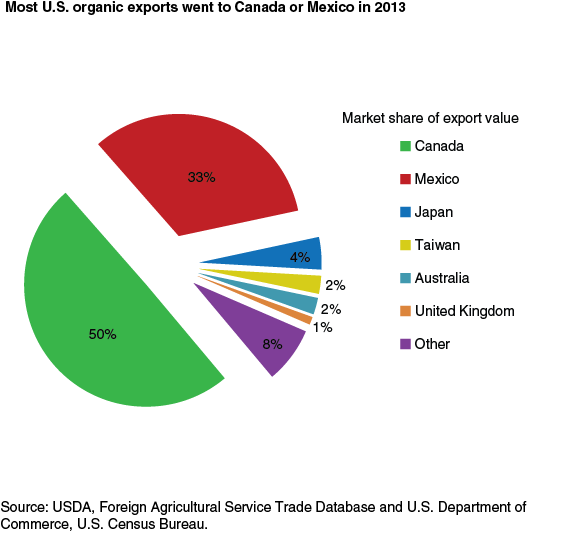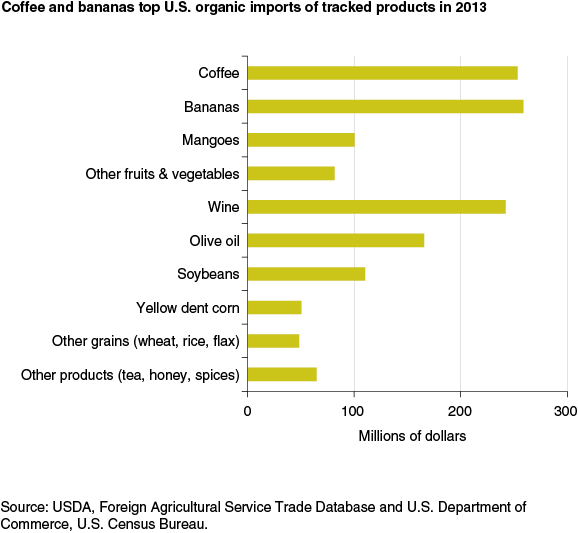U.S. Organic Trade Includes Fresh Produce Exports and Tropical Imports
- by Catherine Greene
- 8/4/2014
The United States has developed an active organic trade sector in recent years with organic trade partners around the world. In 2013, the United States exported organic products consisting mostly of fresh fruits and vegetables to over 80 countries and imported organic products, including coffee, bananas, and olive oil, from nearly 100 countries. Canada and Mexico were the top trade partners for organic exports, and Mexico, Italy, Peru, and Columbia were the top partners for organic imports. According to the Swiss Research Institute of Organic Agriculture (FiBL), certified organic agricultural products are produced in over 160 countries worldwide, and the two largest markets are the United States and Europe. U.S. organic imports must meet USDA’s regulatory standards for organic production and handling.
While most countries don’t monitor trade in organic products, the U.S. Department of Commerce began tracking the trade value of some organic products several years ago and is expanding the number of organic items tracked. Each new organic product added to the trade code system must meet minimum requirements on product value and the number of importers and exporters. In 2013, the value of tracked U.S. organic exports was $537 million, and the value of tracked U.S. organic imports was $1.4 billion.
Most U.S. Organic Exports Are Fresh Fruits and Vegetables
Fresh fruits and vegetables is still the top organic sector in production and sales in the United States and dominates the trade items that Commerce is currently tracking. Fresh and chilled fruits and vegetables accounted for over 90 percent of the Nation’s $537 million in organic export sales last year. The top three U.S. organic exports (in value) in 2013 were apples, lettuce, and grapes. Similarly, apples and grapes are among the top three conventional fresh produce exports.
Canada and Mexico are the top markets for U.S. organic exports, mirroring the conventional sector. Organic exports to these two countries accounted for 83 percent of the value of tracked U.S. organic exports in 2013, although the United States exported organic products to over 80 countries, with Japan, Taiwan, and Australia also among the top trade partners. U.S. organic exports grew 25 percent between 2011 and 2013, with a rise in fresh apple exports to Mexico accounting for much of this increase.
To help open new markets for organic farmers and handlers in the United States, USDA has streamlined trade with multiple foreign governments. The United States implemented an organic equivalence trade agreement with Canada in 2009, the European Union in 2012, and with Japan in early 2014. These trade partnerships allow U.S. organic products to be sold as organic in these countries if they have been certified to the U.S. standard, and vice versa.
Organic Imports Feature Tropical Products
Organic imports must either be certified to USDA organic standards or to an authorized international standard under an established U.S. trade partnership. In 2013, the top U.S. organic imports (in value) were mostly tropical and subtropical products that the United States does not produce in large quantities. Imported organic coffee ($253 million), bananas ($259 million), olive oil ($166 million), and mangos ($101 million) accounted for 60 percent of the value of tracked organic imports in 2013. The United States also imported soybeans worth over $100 million and other grains worth nearly $100 million, mostly to help fill domestic supply gaps for organic feed grains. The top 5 supplying countries—Mexico, Italy, Peru, Columbia, and France—accounted for 40 percent of the value of tracked U.S. organic imports, and nearly 100 countries supplied at least some tracked organic products to the United States in 2013.
This article is drawn from:
- Organic Agriculture. (n.d.). U.S. Department of Agriculture, Economic Research Service.





